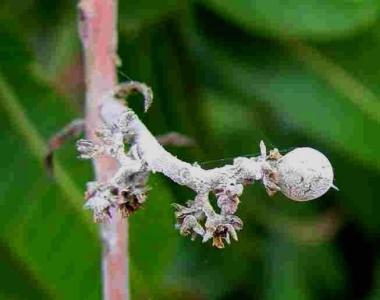
|
Powdery mildew
Scientific name:
Phyllactina spp. / Leveillula spp. / Erysiphe spp. / Uncinula spp. / Blumeria spp. / Golovinomyces spp. / Podosphaera spp. / Sphaerotheca spp.
Order/Family:
Erysiphaceae
Type:
disease (fungal)
Host plants: Beans
Cabbage/Kale, Brassicas
Carrot
Cashew
Cowpea
Cucumber
Eggplant
Green gram
Mango
Okra
Papaya
Peas
Peppers
Pigeon pea
Pumpkin
Sesame
Tomato
Watermelon
Wheat
Zucchini/Courgette
|
| General Information on Disease and Damage | Cultural practices | |||
| Biology and Ecology | Biopesticides and physical methods | |||
| Pest and Disease Management | Information Source Links |
General Information on Disease and Damage
Geographical distribution
 |
| Geographical Distribution of Powdery mildew in Africa (red marked) |
Damage
 |
| Powdery mildew on cabbage. |
| © A.M. Varela, icipe |
Host range
Individual species of powdery mildew fungi typically have a very narrow host range. Hosts include cereals, grasses, vegetables, ornamentals, weeds, shrubs, fruit trees, and forest trees. Notable exceptions include maize, celery and carrots.Genera of powdery mildew fungi and their host plants:
- Phyllactina spp. (Ovulariopsis) attack trees and shrubs
- Leveillula spp. (Oidiopsis) attack Solanaceae
- Erysiphe spp. (Oidium) attack cereals and legumes
- Uncinula spp. (Oidium) attack trees and shrubs
- Blumeria spp. (Oidium) attack grasses
- Golovinomyces spp. (Oidium) attack cucurbits and Compositae
- Podosphaera spp. (Oidium) and Sphaerotheca spp. (Oidium) attack Rosaceae
Symptoms
Even though there are several types of powdery mildew fungi, they all produce similar symptoms on plant parts. Powdery mildews are characterised by spots or patches of white to greyish, talcum-powder-like growth. Tiny, pinhead-sized, spherical fruiting structures that are first white, later yellow-brown and finally black may be present singly or in a group. These are the cleistothecia or over-seasoning bodies of the fungus.
The disease is most commonly observed on the upper sides of the leaves. It also affects the lower sides of leaves, young stems, buds, flowers and young fruit. Infected leaves may become distorted, turn yellow with small patches of green, and fall prematurely. Infected buds may fail to open.
|
|
Affected plant stages
Seeding, vegetative, and reproductive stages. Affected plant parts
Leaves, petioles, stems, and sometimes fruits. Biology and Ecology
Source of infection and spread
The white powdery growth consists of large numbers of fungal spores, which are spread by wind. The disease can spread very rapidly. It is more prevalent in dry weather when humidity is high and nights are cool. The fungus survives from season to season in dormant buds. The flowering is the most critical stage for infection. Conditions that favour development
The severity of the disease depends on many factors: variety of the host plant, age and condition of the plant, and weather conditions during the growing season. Powdery mildews are severe in warm, dry climates. This is because the fungus does not need the presence of water on the leaf surface for infection to occur. However, the relative humidity of the air needs to be high for spore germination. Therefore, the disease is common in crowded plantings where air circulation is poor and in damp, shaded areas. Incidence of infection increases as relative humidity rises to 90%, but it does not occur when leaf surfaces are wet (e.g. in a rain shower). Young, succulent growth usually is more susceptible than older plant tissues.
Pest and Disease Management
Pest and disease management: General illustration of the concept of infonet-biovision

Further below you find concrete preventive and curative methods against Powdery mildew.
Cultural practices
Once the disease becomes a problem:
- Avoid late-season applications of nitrogen fertilizer to limit the production of succulent tissue, which is more susceptible to infection.
- Avoid overhead watering to help reduce the relative humidity.
- Remove and destroy all infected plant parts (leaves, etc.). For infected vegetables and other annuals, remove after harvest as much as possible of the plant and its debris. This decreases the ability of the fungus to survive to next season. Do not compost infected plant debris. Temperatures in the compost often are not hot enough to kill the fungus.
- Selectively prune overcrowded plant material to help increase air circulation. This helps reduce relative humidity and infection.
Biopesticides and physical methods
Information Source Links
- CABI. (2005). Crop Protection Compendium, 2005 Edition. © CAB International Publishing. Wallingford, UK. www.cabi.org
- Heffer, V., Johnson,K.B., Powelson, M.L. and Shishkoff, N. (2006). Identification of Powdery Mildew Fungi anno 2006. The Plant Health Instructor. DOI: 10.1094/PHI-I-2006-0706-01 www.apsnet.org

 Back
Back


